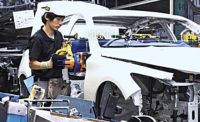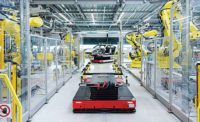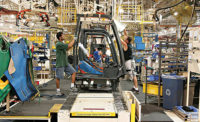A relentless pursuit of continuous improvement and lean manufacturing processes helped Toyota Motor Corp. become the largest automaker in the world. However, as the industry evolves to electric vehicles, the company has been forced to retool its production strategy using a combination of cutting-edge technology and old-school lean thinking.
Various monozukuri technologies are being developed at the Motomachi, Myochi and Teiho plants in Japan. Toyota plans to implement new techniques, such as giga-cast modules, self-propelled assembly lines and digital twin technology, to stay competitive in the quickly evolving auto industry.
It recently held a workshop entitled “Changing the Future of Carmaking” that outlined how the company plans to implement more human-centered manufacturing along with more Industry 4.0 technology.
The new strategy is rooted in the basic principles of the Toyota Production System (TPS), which includes a willingness to do things “for the benefit of someone other than yourself” and a “human-centered” approach to manufacturing.
“At Toyota, we believe that ‘monozukuri is hitozukuri’ (making things is to nurture people),” says Kazuaki Shingo, chief production officer. “The philosophy of ‘doing things for others,’ combined with wisdom and ingenuity, advanced technologies and skills, and the development of human resources equipped with these qualities, are the company’s front line capabilities and the very foundation of monozukuri.
“Even if technology advances and robots are further integrated into production processes, it will be humans equipped with the knowledge of the Toyota Production System who will be able to think of further improvements,” explains Shingo. “With an eye toward ever better manufacturing, [we believe] it is important to train people based on TPS, encouraging the associated skills of masters to be passed on to the next generation, all with an eye toward continuing to advance and evolve monozukuri.
“Through daily improvements, as we continue to work through the cycle of challenging ourselves to continue to reduce lead time, the ability of the front line to respond to evolving customer needs and changing times will support our competitiveness and our efforts to build more than 10 million vehicles annually,” Shingo points out.
According to Shingo, Toyota’s monozukuri will continue to evolve through the fusion of inherited skills and digital tools. “We will halve processes using [our] skills and digital and innovative technology, eliminate the barriers between development and production to provide new mobility quickly, and work to resolve issues at the foundation of monozukuri, such as factory carbon neutrality and logistics,” he explains.
New Age Thinking
Several lean manufacturing experts with extensive knowledge of Toyota’s production philosophy recently weighed in on Shingo’s remarks. They believe that the new initiative represents a next-generation version of TPS designed for the era of digital manufacturing and electric vehicles.
“One of the most remarkable aspects of Toyota’s approach is the seamless interaction between humans and robots in automation,” says Lando Nishida, senior managing director at Honsha Associates. “This balance between human expertise and technological innovation is truly unique.
“For instance, in Toyota’s factories, operators are not just overseeing robots; they are actively involved in training them, promoting a culture of continuous improvement for both humans and machines,” explains Nishida, who heads up Honsha’s digital initiatives. “This emphasizes Toyota’s commitment to achieving the highest standards of quality, and it’s also a testament to the responsibility and engagement of the entire team.
“Compared to other companies, Toyota sets itself apart by effectively harmonizing human skills with cutting-edge technology,” Nishida points out. “This approach results in not only high-quality products, but also the flexibility needed to swiftly adapt to changes in the market. It’s a model of production that combines the best of both worlds, where human experience and technological advancement go hand in hand to create products that truly stand out.
“Toyota sets itself apart by effectively harmonizing human skills with cutting-edge technology.”
– Lando Nishida, senior managing director at Honsha Associates
“Toyota offers a valuable lesson to all of us, regardless of the industry we’re in,” claims Nishida. “It’s a reminder that the key to success lies in our ability to effectively blend human capabilities with technology.”
“Working in Toyota in the mid-1980s was very much like working there two or three decades later,” adds Sammy Obara, senior partner at Honsha Associates. “It always felt like there were tremendous changes, but they were all results from a number of relentless continuous improvements.
“I felt quite a difference the last time I was there in 2022,” says Obara, who spent three years studying lean manufacturing principles in Toyota City and another 10 years applying it at Toyota assembly plants in Brazil, Venezuela and the United States. “I still saw countless kaizens in all processes, many of them simple; not those sophisticated and robust technology-laden implementations.
“But, this time, I saw much more use of flat screens replacing the old manually updated management boards,” recalls Obara. “I saw drones being used in maintenance functions and several meetings taking place via video, even between people in the same building.
“What caught my attention the most was seeing see the famous genchi genbutsu (real place, real facts) now being done via video,” notes Obara. “Toyota engineers [designed a] vest to hold a camera, so remote people would not need to be on site to see it all.
“Needless to say, genchi genbutsu is a core practice at the foundation of the Toyota Way,” says Obara. “It is a must-go-and-see-with-your-own-eyes precept. [During my recent visit], I felt that Toyota was catching up quickly with much of the technology that has been used by its competitors for years.
“However, they did that after they were convinced that the entire purpose could be met by that new technology,” Obara points out. “It is almost as if they wanted to ensure their roots were not lost when utilizing technology.”
New Tools and Technology
Toyota’s next-generation EVs will be built upon a new modular structure in which car bodies are divided into three sections: front, center and rear (earlier this year, Tesla outlined a similar assembly concept). The center section will house solid-state batteries, which offer faster charging and longer range than conventional batteries.
The new modular structure entails dividing the underbody, including the front frame and the cabin floor, into three sections, each fitted with its own parts.
According to Shingo, this approach will improve production efficiency, since operators will no longer need to climb inside a vehicle during assembly. “With this new vehicle structure, seats and other components can be mounted before the roof and side panels are attached, simplifying the designs and operations of robots and other equipment,” he explains.
Giga-casting is one of the new production technologies that will make these modular structures possible. Currently, the rear section of the Toyota bZ4X EV is made with 86 sheet metal parts and 33 press processes.
“Using integrated molding with aluminum die-casting can reduce this to a single part made by a single process,” claims Shingo. “This approach seeks to reduce both cost and weight below conventional models, as well as boost productivity.”
The process starts with injecting molten aluminum alloy into a mold at high speed and pressure. In a matter of seconds, the material is cooled from 700 C to 250 C and solidified, then the mold is opened to remove the integrated cast part.
To explore uses for giga casting in mass production, Toyota engineers focused on improving productivity by reducing two types of waste: downtime during mold replacement and defects or reworking.
“Whereas a typical changeover might take 24 hours and require a large crane, giga-casting molds, which weigh more than 100 tons, leads to even greater time loss,” says Shingo. “[Our new] approach to giga casting divides molds into two types: general-purpose molds that remain mounted on the machinery and specialized molds whose shape differs by car model. During a replacement, only the compact specialized molds detach themselves automatically from the general-purpose molds.”
With these just-in-time mold changes—replacing only what is needed, when it is needed, in the quantity needed—Toyota is aiming to bring lead times down to 20 minutes or less.
“This division of molds and automated mounting-detaching is the culmination of improvements made over many years of handling every aspect of mold design, fabrication and maintenance in-house,” explains Shingo. “When molds expand or contract under the heat of casting, the general-purpose and specialized parts may become misaligned, with the latter unable to release. The necessary clearance is maintained by the skills of mold craftsmen.”
The second type of waste stems from defects and reworking. In their giga-casting analysis, Toyota engineers used proprietary simulation software that draws on expertise accumulated in the mass production of engine blocks and other components. Takumi (artisan) skills have also been digitized and incorporated into parameters and computation methods to create high-quality parts.
“Amid a general trend toward using commercially available equipment, in-house development allows [us] to add parameters or change computation methods,” Shingo points out. “Building high quality into the machinery reduces the number of defects.
“Driven by the skills of experts with intimate knowledge of casting, as well as the waste and lead time reductions made possible by the TPS, [our] monozukuri continues to improve and evolve,” says Shingo.
Toyota engineers have also developed a “self-driving assembly line” that enables vehicles to move between workstations on their own.
“At a minimum, a vehicle needs only the three modular components and a battery, motor, tires and wireless terminal to drive independently,” claims Shingo. “Such a setup eliminates conveyors from the assembly line, allowing for more flexible factory layouts. This will help shorten the years-long lead times needed to prepare for mass production and reduce the required plant investment.
“This self-propelled assembly line utilizes the vehicle control and sensor technologies that [we have] cultivated through the development of autonomous driving,” notes Shingo. “Cameras [and lidar sensors installed] throughout the plant track the cars, keeping them moving along the set route at 0.22 mile per hour.”
A simplified line concept using unmanned transport has already been trialed in part of the welding process for NOAH and Voxy models at the Motomachi assembly plant, which is Toyota’s most flexible factory.
Toyota engineers are also using digital twin technology to design two-way production processes that boost productivity and efficiency. The goal is to improve plants and equipment through interactive frontline improvements that are enhanced digitally before being fed back to the plant floor.
“Before coming into the hands of [operators], new production equipment usually undergoes a process of design, parts machining and assembly,” says Shingo. “However, the drawings prepared in the design stage may include parts whose shape proves impossible to machine.
“The equipment may not run properly after being adjusted or the people on the production floor may find it hard to use,” explains Shingo. “Much of the manufacturing lead time is taken up dealing with such issues, causing waste through defects and reworking.
“To tackle this, [our new] current process uses 3D drawings and involves workers from later stages of production, who view the drawings as they are being prepared and share expertise that is incorporated into the designs,” notes Shingo.
“[We are] transforming the way employees work through a holistic approach that encompasses the entire equipment manufacturing process,” says Shingo. “As part of efforts to shorten lead times, [we are] aiming to eliminate reworking by bringing forward and synchronizing jobs.”
Learn about new products for automotive assembly
Efficient and Reliable: TS 5 Conveyors for Loads up to 400kg
Painless Pad Printing Automation
Automation Platform for Complex HV Cable Processing
Featuring our DuPas Brand offering an operating range of 1 to 450 NM in the following Models:
Automated Robotic Assembly, Brazing & Dispensing Machines













